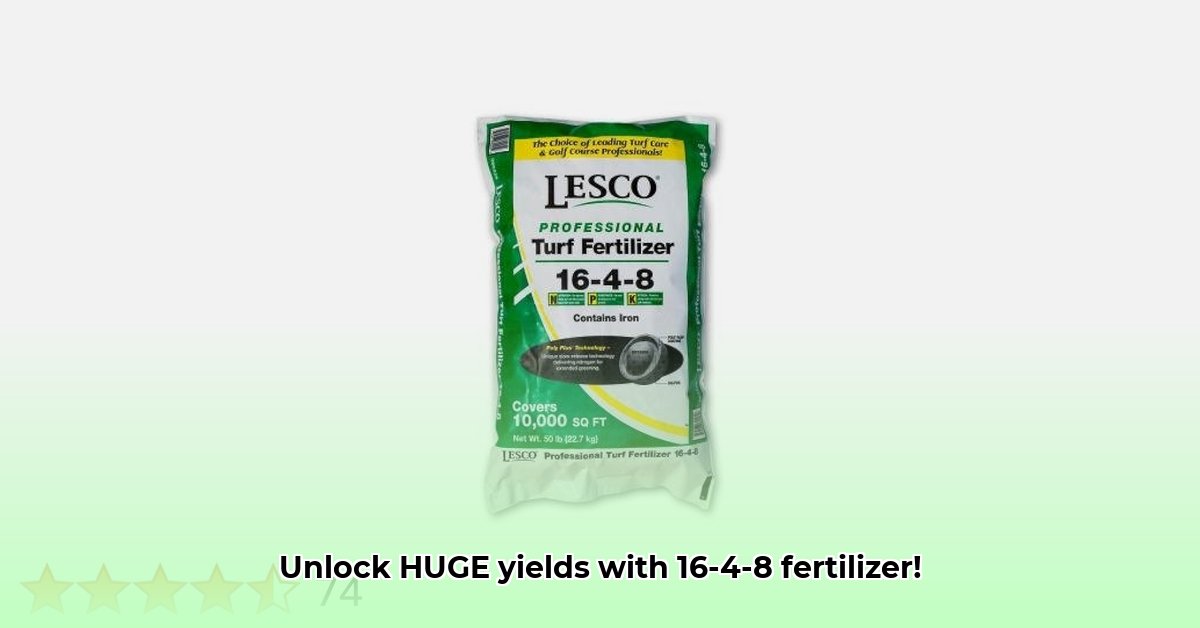
This comprehensive guide provides a step-by-step approach to using 16-4-8 fertilizer from Tractor Supply effectively and responsibly, maximizing yields while minimizing environmental impact. Whether you're a seasoned farmer or a home gardener, this guide will help you understand the best practices for utilizing this common fertilizer. For information on other fertilizer options, see this helpful resource on different NPK ratios.
Decoding 16-4-8 Fertilizer: Understanding the Numbers
The numbers “16-4-8” on the fertilizer bag represent the percentage, by weight, of the three primary macronutrients: Nitrogen (N), Phosphorus (P2O5), and Potassium (K2O). This specific blend contains 16% nitrogen, 4% phosphorus, and 8% potassium. Nitrogen is crucial for vigorous vegetative growth, making 16-4-8 suitable for leafy greens, lawns, and certain fruits and flowers. However, understanding your soil's composition is just as critical. Isn't it surprising how much the soil dictates fertilizer choices?
Soil Testing: The Cornerstone of Efficient Fertilizer Use
Before applying any fertilizer, a soil test is essential. A soil test (easily obtained through a local agricultural extension office or a home testing kit) reveals your soil's existing nutrient levels, pH balance, and other key factors affecting plant health. This avoids over-fertilization, a costly and environmentally damaging practice. Imagine trying to build a house without checking the foundation – soil testing is your garden's "foundation check." How can you make informed fertilization decisions without knowing your soil's needs?
Calculating Application Rates: A Precise Approach
Your soil test results will guide your fertilizer application rate. The nitrogen requirement for your specific crop, found on seed packets or through agricultural resources, is key. Remember, 16-4-8 fertilizer only contains 16% nitrogen. You'll need to calculate the amount needed to deliver the required nitrogen based on your soil test's recommendations. Many free online calculators streamline this process. Over-application leads to wasted fertilizer and environmental damage. What's the ideal balance between providing sufficient nutrients and avoiding excess?
Optimal Application Techniques: Maximizing Nutrient Uptake
Different application methods suit various situations:
Broadcasting: Evenly scattering fertilizer over the soil's surface, ideal for lawns and large areas.
Banding: Applying fertilizer in rows alongside plants, more efficient for row crops because it concentrates nutrients close to the root systems.
Side-dressing: Applying fertilizer near established plants, especially beneficial for crops needing a nitrogen boost during later growth stages.
Timing is crucial: Apply fertilizer when plants actively need nutrients and avoid applying right before heavy rainfall to prevent nutrient runoff. Always wear appropriate safety gear, including gloves and eye protection. What is the most efficient application method for your specific garden setting?
Minimizing Environmental Impact: Sustainable Fertilization
Excess nitrogen leads to groundwater and surface water contamination. Precise application based on soil test results is paramount. Other sustainable practices, such as cover cropping (planting nitrogen-fixing plants like clover) and crop rotation, improve soil health and reduce reliance on synthetic fertilizers. These methods not only enhance the environment but also create healthier soil for future harvests. How can we optimize fertilizer use to minimize its environmental impact?
Comparing 16-4-8 to Alternatives: Informed Decision-Making
16-4-8 is a convenient option, but alternatives exist:
Other Nitrogen Fertilizers: Different NPK ratios cater to specific plant needs and soil conditions.
Organic Fertilizers (Compost): Offer slow-release nutrients and improve soil structure – long-term benefits.
Consider your specific needs, budget, and environmental goals when choosing the best fertilizer. Which option best suits your gardening goals and sustainability philosophy?
Troubleshooting Common Issues: Addressing Fertilizer-Related Problems
Nutrient Deficiencies: Yellowed leaves or stunted growth indicate insufficient nutrients. Adjust application rates or consider a different fertilizer blend.
Fertilizer Burn: Brown or scorched areas on plants point to over-application. Reduce the application rate and dilute the fertilizer for future applications.
Always consult your local agricultural extension office for expert guidance when facing challenges. What are the key indicators of nutrient deficiency versus fertilizer burn?
Summary Table: A Quick Reference Guide
| Step | Action | Considerations |
|---|---|---|
| 1. Soil Testing | Conduct a comprehensive soil test. | Use a reliable testing service or home kit for accurate results. |
| 2. Calculation | Calculate the precise amount of 16-4-8 needed based on the soil test and plant requirements. | Account for the 16% nitrogen content of the 16-4-8 fertilizer. |
| 3. Application | Choose an appropriate application method (broadcasting, banding, side-dressing). | Consider plant type, soil type, and weather conditions. |
| 4. Timing | Apply fertilizer at optimal times, avoiding periods of heavy rain or wind. | Ensure the plants are actively growing. |
| 5. Monitoring | Regularly monitor plants for nutrient deficiencies or fertilizer burn. | Correct any problems promptly to maintain plant health and yields. |
Responsible fertilizer use is crucial for sustainable gardening and environmental protection. By following this guide, you can maximize your yields while contributing to a healthier planet.